Common Horse Hoof Problems | Thrush | Laminitis .. .Signs, Symptoms and Treatment.
Dehydration
Dehydrated hooves…hoof cracks, pain and discomfort, this can be a real problem for the horse and horse owner. There are several ways to provide moisture/hydration to the hooves.
If the hoof capsule becomes dehydrated, it will prevent normal shock absorption. When this happens, the concussion on impact shoots directly up the leg which can result in pain, a jarring gait and lameness. If this goes on long enough you may see shoulder, wither and spinal problems.
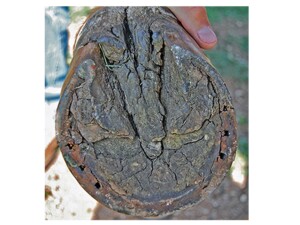
If you have been soaking your horses hooves be mindful that some soaking is good but over soaking can be bad and actually cause hoof cracks. It is important to keep your horse hydrated from the inside, make sure they are drinking plenty of water.
Heat that comes from the ground can effect hoof hydration. Things you can do to help with this is: provide shade trees, grass, soil, or pea gravel and remove metal shoes when possible. Provide access to cool water for the horse to stand in.
There are things that you can apply topically to both the hoof wall, sole and frog. Read the labels of the hoof products you are applying to your horses hooves and avoid products that contain alcohol, glycerin, lanolin, petroleum, etc… what you apply to the hoof will be absorbed into the bloodstream.
Ditch the commercial hoof moisturizers! You can apply natural plant oil based products daily. Coconut Oil, Aloe Gel and some of the essential oils are great choices for providing hydration to the hooves. Contact me for more suggestions on keeping hooves hydrated!
Abscess
Symptoms:
Abscesses in the hoof are typically characterized by sudden-onset, severe lameness. In some cases, the horse may refuse to put any weight at all
on the affected hoof. The horse will be sensitive in the area of the abscess and may have an increased digital pulse and swelling in the lower leg. If left untreated the abscess may erupt on its own through the sole of the hoof or at the coronary band.
Causes:
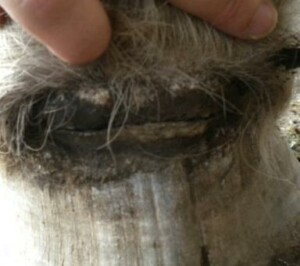
A hoof abscess is a pocket of infection in the laminae. It can start with a puncture wound caused by the horse stepping on a sharp object, or many other causes. The hole allows bacteria to enter the hoof, where it thrives in the warm, dark environment. While the bacteria eat away at the hoof tissue, the horse’s immune system attacks. The resulting pocket of bacteria, white blood cells, and dead hoof tissue puts pressure on the sensitive structures of the horse’s hoof, causing the pain response.
Treatment:
If the abscess is easily located and drained, the key is to keep the area clean to avoid reinfection. The hoof should be soaked in a solution of Epsom salts in warm water to help draw out any remaining infection or to draw out an abscess that is not easily located. The hoof should be kept bandaged until it has healed. An anti-inflammatory may be needed, to manage the horse’s pain and Equine Challenge™ Laminae 911 is highly recommended. The recovery period can be a week to ten days, but this can vary widely depending on the severity of the abscess and the owner’s ability to prevent reinfection.
Bruises
Symptoms:
A horse with a bruised hoof can show varying degrees of lameness. Some will be off only on uneven or rocky surfaces while others may be consistently lame. A sole bruise may show up as a visible mark, but a horse will usually show lameness or sensitivity before the bruise actually appears.
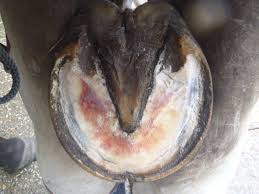
Causes:
Bruises on the hoof and frog are very common. The most common cause is when the horse steps on a rock or hard, uneven ground. Crusty, icy snow can also lead to bruises. Regular work on arena footing that is too hard can also cause bruising, as can taking a horse that is primarily ridden on soft footing and working him on hard ground. Improper farrier work can also lead to bruising.
Some horses have thinner soles or flatter feet than others. This can predispose a horse to bruises. Left untreated, a simple bruise can become an abscess as more blood pools in the affected area.
Treatment:
If your horse is showing signs of bruising, soak the affected hoof in ice water. This will prevent the rapid blood flow to the area that causes bruising. In more severe cases, you may need to treat with an anti-inflammatory and again, Equine Challenge™Laminae 911 is recommended. For thin soled horses we recommend Equine Challenge™Hoof Propel.
You can reduce the risk of bruises by being diligent about picking your horse’s feet daily and before and after every ride to remove any rocks that may be stuck in his hoof. Keeping the hooves clean and dry will also help, as wet soles may be more prone to bruising.
Another option is hoof boots that cover the entire hoof when competing on long rides or over especially rough terrain. These boots can prevent bruises and other hoof injury while giving the horse some extra traction.
Laminitis
Symptoms:
The coffin bone of the interior of a horse’s hoof is attached to the inner hoof wall with Velcro-like structures called laminae. When the sensitive inner laminae become inflamed, the horse is suffering from laminitis. If the inflammation is left untreated, the sensitive laminae are weakened, leading to
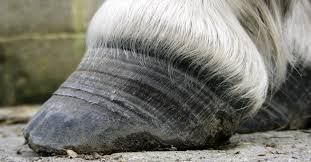
potential separation of the coffin bone and the hoof wall, which can lead to rotation of the coffin bone known as founder. Laminitis causes varying degrees of pain. It can affect one, two or even all four hooves. A laminitic horse may shift his weight back and
forth or stand with both front feet stretched out (often referred to as the sawhorse stance) in an attempt to take weight off of his hooves. The affected hooves will be notably warm or hot and the digital pulse will usually be elevated. If made to walk, the horse may move in a hesitant manner.
Causes:
There are numerous causes for laminitis. A common scenario is one where the horse is let out into a lush, spring pasture and gorges himself on rich grass. The high-carbohydrate, easily digestible spring grass is broken down rapidly by the bacteria in the horse’s gut. This fast digestion causes a byproduct which is absorbed into the horse’s bloodstream where it becomes a sort of toxin, causing inflammation in the laminae. This same scenario can play out in situations where the horse has broken into the feed bin and gorged himself on grain.
Other causes include heavy concussion (such as a horse that gallops or is worked at a high-stepping gait on a hard surface), or a hard workout without appropriate cool down. Exposure to environmental toxins such as black walnut can lead to laminitis. Obese or cresty horses are more prone to laminitis than fit and thin horses, but any horse can be affected.
Laminitis can also become a secondary issue if a horse is compensating for an injury on one leg by putting most of his weight on another.
Treatment:
If laminitis is caught early, standing the affected hooves in ice water can slow the progression of the disease. Equine Challenge™ Laminae 911 is HIGHLY recommended! As hard as it is to watch, a laminitic horse MUST have daily movement!
Horses that have had laminitis can be more prone to it in the future, so proper management is key. The horse should be kept off lush green grass and rich hay during the recovery period. Soaking some grass hay before feeding it to laminitic horses can also be helpful. Overweight horses are more prone to founder, so keeping your horse’s weight down even after he has recovered may be necessary. For more info on getting weight off your horse visit the Equine Challenge™IR page.
Thrush
Symptoms:
Thrush is a bacterial infection that primarily affects the grooves of the Frog. The infection causes a gooey black discharge with a distinctive foul odor.
In most cases, thrush will not cause significant pain, but if left untreated it can cause sensitivity in the frog and heel and ultimately lead to lameness.
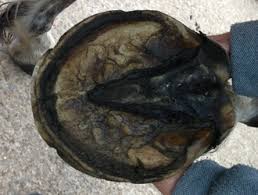
Causes:
Thrush thrives in a wet, dirty environment. Horses kept in a muddy paddock or left to stand in a dirty stall are especially at risk for developing thrush. When mud and manure are packed into the hoof, the dark, warm, wet sulci become the ideal home for bacteria to thrive. The bacteria eat away at the hoof tissue, causing the telltale black discharge.
Treatment:
In most cases, a horse owner can treat thrush quickly and easily by applying a commercial thrush medication, or white vinegar to the sulci. Picking your horse’s feet regularly, keeping your stalls and paddocks clean, and making sure that your horse has somewhere dry to stand in the pasture during wet months are the keys to prevention.
White Line Disease (Seedy Toe)
Symptoms:
White line disease is characterized by a separation of the inner hoof wall which may be visible as a hole or crack on the sole at the toe. Bacteria and fungi invade the space between hoof wall layers. As the infection eats away at the hoof tissue, the hoof may appear white and crumbly when scraped with a hoof pick.
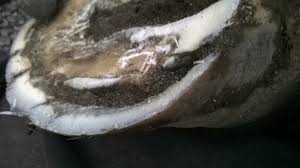
Hooves that are unusually dry and brittle may be a sign of white line disease. Lameness may or may not occur, depending on severity.
Causes:
The exact cause of white line disease is often uncertain. Bacteria and fungus can enter the hoof through undetected openings in the sole. Previous hoof injury, especially laminitis, can leave the hooves at risk for white line disease, and once a horse has been affected, he may be more prone to future bouts of the disease.
The hoof wall at the horse’s toe becomes weaker as it grows longer, so a long toe may be a risk factor for white line disease.
Treatment:
The infection that causes white line disease is anaerobic, meaning it lives in an environment without oxygen. The affected area must be thoroughly cleaned to get rid of the bacteria, fungi and dead tissue.
Keeping your horse’s hooves clean, maintaining his stalls and pastures and keeping him on a regular trimming schedule are the best ways to prevent white line disease.
Thank you for your continued support, contact me with questions!
Kathy Hartwig

